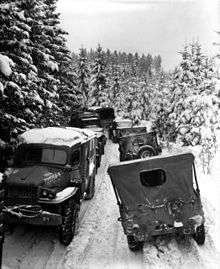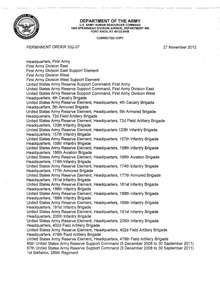87th Infantry Division (United States)
The 87th Infantry Division ("Golden Acorn"[1]) was a unit of the United States Army in World War I and World War II.
| 87th Infantry Division | |
|---|---|
 87th Infantry Division shoulder sleeve insignia | |
| Active | 1917–1919 1921–1945 1946–1954 1993–2015 |
| Country | |
| Branch | |
| Type | Infantry |
| Size | Division |
| Nickname(s) | "Golden Acorn" (special designation)[1] |
| Motto(s) | Stalwart and Strong |
| Engagements | World War I World War II |
| Commanders | |
| Notable commanders | Major General Frank L. Culin |
| Insignia | |
| Distinctive unit insignia | |
World War I
- 87th Division was a National Army division allocated to Arkansas, Louisiana and Mississippi.
- Was activated at Camp Pike, Arkansas on 25 August 1917.
- Went overseas in September 1918, was utilized as a pool of laborers.
- Returned to the Continental US in January 1919 to Camp Dix, New Jersey, and was deactivated in February 1919.
- MG Samuel D. Sturgis (25 August 1917).
- BG Robert Campbell Van Vliet (13 November 1917).
- MG Samuel D. Sturgis.
- COL John O'Shea (6 October 1918).
- MG Samuel D. Sturgis (23 October 1918).
- BG W. F. Martin (22 November 1918).
Order of battle
- Headquarters, 87th Division
- 173rd Infantry Brigade
- 345th Infantry Regiment
- 346th Infantry Regiment
- 335th Machine Gun Battalion
- 174th Infantry Brigade
- 347th Infantry Regiment
- 348th Infantry Regiment
- 336th Machine Gun Battalion
- 162nd Field Artillery Brigade
- 334th Field Artillery Regiment (75 mm)
- 335th Field Artillery Regiment (75 mm)
- 336th Field Artillery Regiment (155 mm)
- 312th Trench Mortar Battery
- 334th Machine Gun Battalion
- 312th Engineer Regiment
- 312th Medical Regiment
- 312th Field Signal Battalion
- Headquarters Troop, 87th Division
- 312th Train Headquarters and Military Police
- 312th Ammunition Train
- 312th Supply Train
- 312th Engineer Train
- 312th Sanitary Train
- 345th, 346th, 347th, and 348th Ambulance Companies and Field Hospitals
Interwar period
The division was reconstituted in the Organized Reserve on 24 June 1921 and assigned to the states of Alabama, Louisiana, and Mississippi. The headquarters was organized on 23 September 1921.
World War II
- Ordered into active military service: 15 December 1942 at Camp McCain, Mississippi.
- Training: Moved to the Tennessee Maneuver Area on 3 December 1943, for the Second Army #4 Tennessee Maneuvers; Consolidated to Fort Jackson, South Carolina on 20 January 1944 for divisional training.
- Staged at Camp Kilmer, at Stelton (now Edison), New Jersey, on 10 October 1944 until it received its Port Call to the New York Port of Embarkation in Brooklyn, NY.
- Overseas: Deployed to the European Theater on 17 October 1944.
- Arrived England on 12 November 1944, and Staged for movement to France.
- Assigned to US 3rd Army on 25 November 1944.
- Arrived Le Havre, France 28 November 1944.
- Was further assigned to US III Corps on 4 December 1944, and to US XII Corps on 11 December 1944, and to US XV Corps on 21 December 1944, and to US VIII Corps on 29 December 1944.
- Crossed into Belgium on 12 January 1945, and returned to XII Corps on 14 January 1945.
- Crossed into Luxembourg on 21 January 1945, and assigned to VIII Corps on 25 January 1945.
- Due to discontinuity of German railroad system, 87th ID was routed to Germany by returning to Belgium on 3 February 1945.
- Entered Germany 16 March 1945, and remained to VE Day.
- Returned to Continental US at New York Port of Embarkation on 11 July 1945, and proceeded to Fort Benning, Georgia on 14 July 1945 to prepare for deployment to Japan.
- Was at Fort Benning on VJ Day.
- 87th Infantry Division was deactivated on 21 September 1945, at Fort Benning, Georgia.
- Campaigns: Rhineland, Ardennes-Alsace, Central Europe.
- Days of combat: 154.
- Distinguished Unit Citation: 2.
- Awards:
- Medal of Honor-1 ;
- Distinguished Service Cross-9 ;
- Distinguished Service Medal-1 ;
- Silver Star-364;
- Legion of Merit −20;
- Soldier's Medal −41 ;
- Bronze Star −1,542 ;
- Air Medal −49.
- Commanders:
- MG Percy W. Clarkson (December 1942 – October 1943),
- MG Eugene M. Landrum (October 1943 – April 1944),
- MG Frank L. Culin Jr. (April 1944 to inactivation).
- Returned to U.S.: 11 July 1945.
- Inactivated: 20 September 1945.
Combat chronicle


The 87th Infantry Division arrived in Scotland, 22 October 1944, and trained in England, 23 October-30 November. It landed in France, 1–3 December, and moved to Metz, where, on 8 December, it went into action against and took Fort Driant. The division then shifted to the vicinity of Gros-Réderching near the Saar-German border on 10 December and captured Rimling, Obergailbach, and Guiderkirch.
The 87th was moving into Germany when, on 16 December 1944, German Field Marshal Von Rundstedt launched his offensive in the Ardennes forest (Battle of the Bulge). The Division was placed in SHAEF (Supreme Headquarters Allied Expeditionary Force) reserve, 24–28 December, then thrown into the Bulge battle in Belgium, 29 December. In a fluctuating battle, it captured Moircy on 30 December and Remagne on 31 December. On 2 January 1945, it took Gérimont, on 10 January Tillet, and reached the Ourthe by 13 January. On 15 January 1945, the division moved to Luxembourg to relieve the 4th Infantry Division along the Sauer and seized Wasserbillig on 23 January. The 87th moved to the vicinity of St. Vith, 28 January, and attacked and captured Schlierbach, Selz, and Hogden by the end of the month. After the fall of Neuendorf, 9 February, the division went on the defensive until 26 February, when Ormont and Hallschlag were taken in night attacks. The 87th crossed the Kyll River, 6 March, took Dollendorf on 8 March, and after a brief rest, returned to combat, 13 March 1945, crossing the Moselle on 16th and clearing Koblenz, 18–19 March. The division crossed the Rhine, 25–26 March, despite strong opposition, consolidated its bridgehead, and secured Grossenlinden and Langgöns. On 7 April, it jumped off in an attack which carried it through Thuringia into Saxony. Plauen fell, 17 April, and the division took up defensive positions, 20 April, about 4 miles from the border to Czechoslovakia. On 6 May 1945, it took Falkenstein and maintained its positions until Victory in Europe Day.
The 87th Division returned to the States in July 1945 expecting to be called upon to play a role in the defeat of the Imperial Japanese, but the sudden termination of the war in the Pacific while the division was reassembling at Fort Benning changed the future of the 87th. The division was inactivated 21 September 1945.
The last active soldier from the division retired in June 1981. Colonel Vedder B. Driscoll (1925–1983), who had enlisted in 1943 and was Platoon Sgt for Company "I", 345th Infantry, retired after 30 years of commissioned service.
Casualties
Assignments in European Theater of Operations
- 25 November 1944: Third Army, 12th Army Group.
- 4 December 1944: III Corps.
- 11 December 1944: XII Corps.
- 21 December 1944: XV Corps, Seventh Army, 6th Army Group.
- 29 December 1944: VIII Corps, Third Army, 12th Army Group.
- 14 January 1945: XII Corps.
- 25 January 1945: VIII Corps.
- 22 April 1945: VIII Corps, First Army, 12th Army Group.
Order of battle
- Headquarters, 87th Infantry Division
- 345th Infantry Regiment
- 346th Infantry Regiment
- 347th Infantry Regiment
- Headquarters and Headquarters Battery, 87th Infantry Division Artillery
- 334th Field Artillery Battalion (105 mm)
- 335th Field Artillery Battalion (155 mm)
- 336th Field Artillery Battalion (105 mm)
- 912th Field Artillery Battalion (105 mm)
- 312th Engineer Combat Battalion
- 312th Medical Battalion
- 87th Cavalry Reconnaissance Troop (Mechanized)
- Headquarters, Special Troops, 87th Infantry Division
- Headquarters Company, 87th Infantry Division
- 787th Ordnance Light Maintenance Company
- 87th Quartermaster Company
- 87th Signal Company
- Military Police Platoon
- Band
- 87th Counterintelligence Corps Detachment
Decorations[3]
| Ribbon | Award | Year | Orders |
|---|---|---|---|
| Army Superior Unit Award | 2008–2011 |  Permanent Orders 332-07 announcing award of the Army Superior Unit award |
Postwar
The 87th Infantry Division was reformed in the Organized Reserve Corps after the war, in the Third Army area. It comprised units in Alabama, Tennessee, Mississippi, and Florida. It was inactivated on 15 February 1957 in Birmingham, Alabama, and subsequently the division shoulder sleeve insignia and number, but not the division lineage and honors, were used by the 87th Maneuver Area Command (MAC), also in Birmingham, with sixteen subordinate battalions.[4] The 87th MAC was later inactivated and, on 1 October 1993, the lineage of the 87th Infantry Division was redesignated as Headquarters, 87th Division (Exercise) and activated at Birmingham, Alabama. On 17 October 1999 it was reorganized and redesignated Headquarters, 87th Division (Training Support).[5]
According to Global Security, "On 16 January 2006, First US Army's mission expanded to include the training, readiness oversight, and mobilization for all US Army Reserve and Army National Guard units within the continental United States and 2 US territories. First US Army assumed authority from Fifth US Army, which was transforming into United States Army North (ARNORTH), assuming nationwide responsibility for homeland security. With its new role, First US Army developed two subordinate multi-component headquarters, one division to support the eastern United States and the other to support the western United States. Division East, First US Army Division East was activated on 7 March 2007, and was headquartered at Fort George G. Meade, Maryland. Division East replaced the functions previously performed by US Army Reserve divisions, like the 87th Division, in its area of responsibility. As a result, the 87th Division's brigades were subsequently inactivated and the 87th Division was reorganized and redesignated as the 87th Army Reserve Support Command. The 87th Army Reserve Support Command assumed command and control of the newly formed Mobilization Support Group East and its 16 subordinate battalions effective 16 October 2008."[6]
On 1 October 2015 the 87th Army Reserve Support Command was inactivated.[7]
References
- "Special Unit Designations". United States Army Center of Military History. 21 April 2010. Archived from the original on 9 July 2010. Retrieved 9 July 2010.
- Army Battle Casualties and Nonbattle Deaths, Final Report (Statistical and Accounting Branch, Office of the Adjutant General, 1 June 1953)
- Permanent Order 332-07
- Pike, John. "87th Army Reserve Support Command (East)". www.globalsecurity.org. Archived from the original on 28 May 2017. Retrieved 23 April 2018.
- https://history.army.mil/html/forcestruc/lineages/branches/div/087d.htm
- https://www.globalsecurity.org/military/agency/army/87d.htm
- Alabama’s 87th Army Reserve Support Command Deactivates Archived 25 August 2016 at the Wayback Machine, WAIT News, by Michael Oder, dated 13 September 2015, last accessed 3 October 2016
- The Army Almanac: A Book of Facts Concerning the Army of the United States U.S. Government Printing Office, 1950 reproduced at
http://www.history.army.mil/html/forcestruc/cbtchron/cbtchron.html.